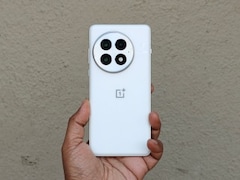-
 Amazon Great Summer Sale 2025: Best Deals on Smartwatches2 May 2025
Amazon Great Summer Sale 2025: Best Deals on Smartwatches2 May 2025 -
 OnePlus 13 Mini Expected to Debut in April; OnePlus 14, OnePlus Ace 6 Series Launch Timeline Tipped7 February 2025
OnePlus 13 Mini Expected to Debut in April; OnePlus 14, OnePlus Ace 6 Series Launch Timeline Tipped7 February 2025 -
 OnePlus Ace 5, OnePlus Ace 6 Series Battery Details Surface Online, Tipped to Pack Up to 7,000mAh Cell8 November 2024
OnePlus Ace 5, OnePlus Ace 6 Series Battery Details Surface Online, Tipped to Pack Up to 7,000mAh Cell8 November 2024 -
 Amazon Great Summer Sale: Top Deals on Samsung, Xiaomi, and OnePlus Tablets4 May 2024
Amazon Great Summer Sale: Top Deals on Samsung, Xiaomi, and OnePlus Tablets4 May 2024 -
 Amazon Prime Day 2023 Sale: Best Offers and Discounts on iPad and Tablets From Xiaomi, OnePlus and Samsung15 July 2023
Amazon Prime Day 2023 Sale: Best Offers and Discounts on iPad and Tablets From Xiaomi, OnePlus and Samsung15 July 2023
- Home
- Mobiles
- Mobiles News
- OnePlus 6 Will Embrace the Notch and Retain a 3.5mm Headphone Jack, Reveals Co Founder Carl Pei
OnePlus 6 Will Embrace the Notch and Retain a 3.5mm Headphone Jack, Reveals Co-Founder Carl Pei 93x36
By Gadgets 360 Staff | Updated: 28 March 2018 18:30 IST

Photo Credit: OnePlus/ The Verge 1d2t2c
ment
Carl Pei made the revelations in an interview that also explained the Chinese company's motivations for the move, as well as UI changes it will make to accommodate the notch in its design.
Speaking to The Verge, Pei Face ID tech. It will measure 19.616x7.687mm.
Pei also said OnePlus had manually tested 1,000 of the top Google Play apps to see how they would react to the inclusion of the notch, and to assess what sort of compatibility mode the company would need to engineer. The OnePlus 6 will move the clock to the left of the display, providing more space for the other status icons. Pei also said the smartphone would hide the notch when a full-screen video is playing. Other revelations made by Pei included the fact the smartphone would house the largest display in a OnePlus device yet, have a screen-to-body ratio of 90 percent, and that it won't be larger than any of the current OnePlus flagship models in size. Pei also said the OnePlus 6 won't be identical to the recent speculation had concluded.
As for the company's motivations to use a notch in the display of its next flagship smartphone, Pei said OnePlus wants to give s as much screen real estate as possible, and to achieve this, the notch is the best way forward. It has already started testing iPhone X-like gesture-based inputs on its previous flagships to help remove the need for Android's onscreen navigation buttons. The notch will then help further the aim of more screen estate by moving the notification and status bar into the spaces on either side of it.
In the interview, Pei confirmed that the iPhone X was indeed an inspiration for the company, agreeing that Apple "accelerates the adoption of things within the industry", at least, "where it makes sense." Pei explained that last line, saying that the OnePlus 6 will retain the 3.5mm headphone jack. Also unlike the iPhone X, the OnePlus 6 would retain a bottom chin - this is not for any aesthetic or a UX-based reason, but rather because Apple's implementation is too expensive. The Cupertino giant employed a flexible OLED that moves the ribbon connector seen in conventional displays to the back of the smartphone by bending it backwards. With the price constraints that Android manufacturers work with, this wouldn't be a feasible solution for them, Pei added. Instead, they would retain the bottom chin design to house the display's ribbon connector.
Do Oppo F7 and Vivo V9 show what to expect from OnePlus 6? We discussed that on Orbital, our weekly technology podcast, which you can subscribe to via Apple Podcasts or RSS, the episode, or just hit the play button below.
Comments
For the latest reviews, follow Gadgets 360 on X, Facebook, WhatsApp, Threads and Google News. For the latest videos on gadgets and tech, subscribe to our YouTube channel. If you want to know everything about top influencers, follow our in-house Who'sThat360 on Instagram and YouTube.
Further reading: Notch
Related Stories x6q4h
Popular on Gadgets
- Samsung Galaxy Unpacked 2025
- ChatGPT
- Redmi Note 14 Pro+
- iPhone 16
- Apple Vision Pro
- Oneplus 12
- OnePlus Nord CE 3 Lite 5G
- iPhone 13
- Xiaomi 14 Pro
- Oppo Find N3
- Tecno Spark Go (2023)
- Realme V30
- Best Phones Under 25000
- Samsung Galaxy S24 Series
- Cryptocurrency
- iQoo 12
- Samsung Galaxy S24 Ultra
- Giottus
- Samsung Galaxy Z Flip 5
- Apple 'Scary Fast'
- Housefull 5
- GoPro Hero 12 Black Review
- Invincible Season 2
- JioGlass
- HD Ready TV
- Laptop Under 50000
- Smartwatch Under 10000
- Latest Mobile Phones
- Compare Phones
Latest Gadgets
- Lava Bold N1 Pro
- Lava Bold N1
- Tecno Pova Curve 5G
- Motorola Edge 2025
- OnePlus Ace 5 Racing Edition
- OnePlus Ace 5 Ultra
- Realme GT 7 Dream Edition
- Realme GT 7T
- Acer Swift Neo
- Asus ExpertBook P3 (P3606)
- Honor Pad 10
- Xiaomi Pad 7 Ultra
- Xiaomi Watch S4 15th Anniversary Edition
- iQOO Watch 5
- Haier 43 Inch QLED Ultra HD (4K) Smart TV (43H6E)
- Haier 55 Inch QLED Ultra HD (4K) Smart TV (55H6E)
- Asus ROG Ally
- Nintendo Switch Lite
- Haier 1.6 Ton 5 Star Inverter Split AC (HSU19G-MZAID5BN-INV)
- Haier 1.6 Ton 5 Star Inverter Split AC (HSU19G-MZAIM5BN-INV)
© Copyright Red Pixels Ventures Limited 2025. All rights reserved.


















